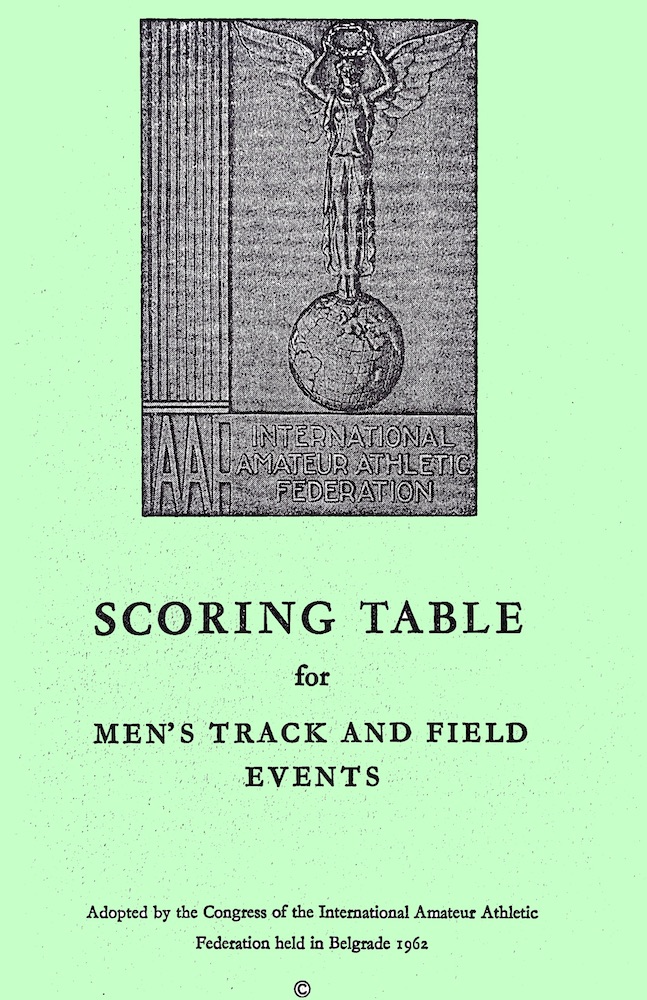As I explained in a previous post on scoring, the tables proposed by Holmer and Jörbecck were not a real success. Their exaggerated progressivity was too much of a good thing. In the meantime it became urgent to provide scoring for women's combined events. Having neglected women's athletics for decades (probably in the hope that they would go away) the IAAF found themselves in dire need of scoring tables for women's events. So, a working group was formed, coordinated by Jörbeck and in 1954 the first official scoring tables for women were proposed. The story of women's combined events and their scoring is one that I told in a recent post of mine.
In the meantime the necessity for new tables for men was becoming urgent. Jörbeck, who had had some success with the women tables was again at the head of the working group. Several proposals were examined and the one that was adopted was one based on the theories of Dr. Karl Ulbrich. My friend Gerry Purdy in the bibliography of his PhD thesis is summarising the situation.
I love the sentence "since he stole it from Ulbrich". Those are things that one could say in the 70s, and which are unthinkable now-a-days where the politically correct has dominated our speech and our way of thinking.
But let us go back to Ulbrich. Karl Ulbrich was an Austrian engineer. He was born in 1905 and did his studies at the Vienna University of Technology where he obtained his doctorate on geodesics. He worked from 1928 at the Federal Office for Metrology and Surveying till his retirement in 1970. He passed away in 1987. Ulbrich had a keen interest in athletics (he had been an athlete, running the 110 m hurdles in 17.7 s at the age of 18). In 1950 he published a treatise in the Schriftenreihe der Bundesanstalten für Leibenserziehung. Purdy speaks of Ulbrich with deference. Here is what he writes.
In 1959, the IAAF technical committee asked A. Jörbeck to propose a new scoring table to replace the 1952 tables. Between this time and 1962 Jörbeck examined a number of different proposals which were submitted for consideration. Jörbeck filed his report with the IAAF in 1960 and his concluding remarks were:
I have received several proposals for a new scoring table for men. I have tested them all and I have found that many of the proposals do not correspond to the [IAAF] demands. The best of the proposals which I have received is in my opinion that of Dr. Karl Ulbrich. His table is very carefully done and does not differ much from that which is proposed by me.
And Purdy explains what is really meant by this last sentence.
For people who are really interested by scoring, Ulbrich's paper is a must. He presented a thorough analysis of the situation. In the introduction he stated that he has been working on the question of scoring since 1936. He made clear from the outset that the quantity in which the tables must be cast for track events is the velocity. And then disaster struck. Ulbrich decided that velocity was the quantity that was determining the performance in field events. This is perfectly true in the sense that the performance is directly related to the square of the velocity (in fact to the kinetic energy the athlete imparts upon his body or the implement). But Ulbrich decided that it was the first power of the velocity that was important and thus proposed a scoring system where the number of points p were related to the square root of the performance x.
Unfortunately this is a major blunder. The consequence of such an assumption is that the tables for all field events are regressive. (I have trouble understanding how Ulbrich reached such an absurd conclusion. The only explanation I can find is that he was more focused on the mathematics of the question and not so on physics. To a physicist, it is clear that the important quantity is the energy).
The tables based on Ulbrich's approach were adopted in 1962. Jörbeck was an adept at obfuscation and it took quite some time for the huge drawback of the tables to become apparent.






No comments:
Post a Comment